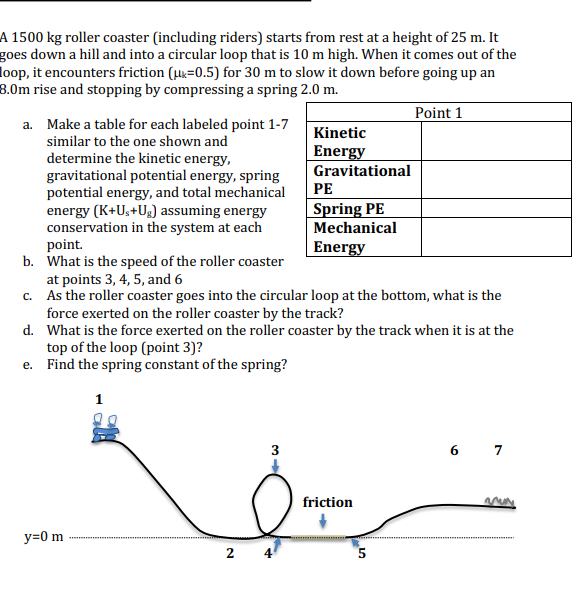A 1500 kg roller coaster (including riders) starts from rest at a height of 25 m. It goes down a hill and into a circular loop that is 10 m high. When it comes out of the oop, it encounters friction (µk=0.5) for 30 m to slow it down before going up an 3.0m rise and stopping by compressing a spring 2.0 m.
A 1500 kg roller coaster (including riders) starts from rest at a height of 25 m. It goes down a hill and into a circular loop that is 10 m high. When it comes out of the oop, it encounters friction (µk=0.5) for 30 m to slow it down before going up an 3.0m rise and stopping by compressing a spring 2.0 m.
University Physics Volume 1
18th Edition
ISBN:9781938168277
Author:William Moebs, Samuel J. Ling, Jeff Sanny
Publisher:William Moebs, Samuel J. Ling, Jeff Sanny
Chapter8: Potential Energy And Conservation Of Energy
Section: Chapter Questions
Problem 59P: In the movie Monty Python and the Holy Grail (https://openstaxcollege. org/l/21monpytmovcl) a cow is...
Related questions
Topic Video
Question

Transcribed Image Text:A 1500 kg roller coaster (including riders) starts from rest at a height of 25 m. It
goes down a hill and into a circular loop that is 10 m high. When it comes out of the
loop, it encounters friction (µk=0.5) for 30 m to slow it down before going up an
8.0m rise and stopping by compressing a spring 2.0 m.
Point 1
a. Make a table for each labeled point 1-7
similar to the one shown and
determine the kinetic energy,
gravitational potential energy, spring
potential energy, and total mechanical
energy (K+Us+Ug) assuming energy
conservation in the system at each
point.
b. What is the speed of the roller coaster
at points 3, 4, 5, and 6
c. As the roller coaster goes into the circular loop at the bottom, what is the
Kinetic
Energy
Gravitational
PE
|Spring PE
Mechanical
Energy
force exerted on the roller coaster by the track?
d. What is the force exerted on the roller coaster by the track when it is at the
top of the loop (point 3)?
e. Find the spring constant of the spring?
1
3
6 7
friction
y=0 m
2
Expert Solution
This question has been solved!
Explore an expertly crafted, step-by-step solution for a thorough understanding of key concepts.
This is a popular solution!
Trending now
This is a popular solution!
Step by step
Solved in 8 steps with 8 images

Knowledge Booster
Learn more about
Need a deep-dive on the concept behind this application? Look no further. Learn more about this topic, physics and related others by exploring similar questions and additional content below.Recommended textbooks for you

University Physics Volume 1
Physics
ISBN:
9781938168277
Author:
William Moebs, Samuel J. Ling, Jeff Sanny
Publisher:
OpenStax - Rice University

College Physics
Physics
ISBN:
9781305952300
Author:
Raymond A. Serway, Chris Vuille
Publisher:
Cengage Learning

Principles of Physics: A Calculus-Based Text
Physics
ISBN:
9781133104261
Author:
Raymond A. Serway, John W. Jewett
Publisher:
Cengage Learning

University Physics Volume 1
Physics
ISBN:
9781938168277
Author:
William Moebs, Samuel J. Ling, Jeff Sanny
Publisher:
OpenStax - Rice University

College Physics
Physics
ISBN:
9781305952300
Author:
Raymond A. Serway, Chris Vuille
Publisher:
Cengage Learning

Principles of Physics: A Calculus-Based Text
Physics
ISBN:
9781133104261
Author:
Raymond A. Serway, John W. Jewett
Publisher:
Cengage Learning

College Physics
Physics
ISBN:
9781938168000
Author:
Paul Peter Urone, Roger Hinrichs
Publisher:
OpenStax College

College Physics
Physics
ISBN:
9781285737027
Author:
Raymond A. Serway, Chris Vuille
Publisher:
Cengage Learning

An Introduction to Physical Science
Physics
ISBN:
9781305079137
Author:
James Shipman, Jerry D. Wilson, Charles A. Higgins, Omar Torres
Publisher:
Cengage Learning